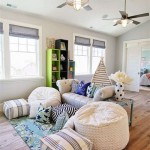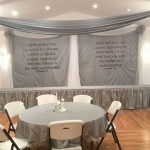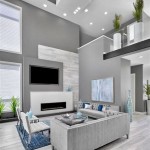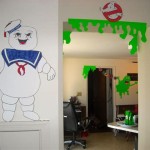How To Decorate A Big Bedroom
Decorating a large bedroom presents a unique set of design challenges and opportunities. Unlike smaller spaces, a bigger bedroom necessitates careful planning to ensure the room feels cohesive, inviting, and appropriately scaled. Neglecting this planning can result in a space that feels cold, empty, and unwelcoming. The key lies in strategically utilizing the available square footage to create distinct zones, optimize furniture placement, and employ design elements that foster a sense of warmth and intimacy.
Before embarking on any decorating endeavor, it is crucial to thoroughly assess the room's dimensions and features. This assessment should include accurately measuring the length, width, and height of the space, noting the location of windows, doors, and any architectural details such as fireplaces or built-in closets. Understanding these elements will inform decisions regarding furniture size, layout, and overall design scheme. Furthermore, the natural light available in the room should be considered, as it will affect paint color choices and the placement of artificial lighting fixtures.
Defining Zones Within the Bedroom
One of the most effective strategies for decorating a large bedroom is to divide it into distinct functional zones. This approach prevents the room from feeling like a single, vast expanse and allows for the creation of dedicated areas for specific activities. Common zones within a large bedroom might include a sleeping area, a reading nook, a dressing area, a workspace, or even a small seating area for relaxation. Defining these zones helps to establish visual order and enhance the room's overall functionality.
The sleeping area, naturally, should be the focal point of the bedroom. The bed should be appropriately sized for the room, avoiding the selection of a bed that is too small and appears lost in the space. A large headboard can further accentuate the bed and create a sense of grandeur. Bedside tables with lamps and storage are essential components of this zone, providing both functionality and visual symmetry. Consider incorporating a rug beneath the bed to anchor the sleeping area and add warmth and texture. The placement of the bed itself is crucial; avoid placing it directly in line with the door if possible, and consider orienting it towards a view if one is available.
A reading nook can transform an unused corner into a cozy and inviting space. This zone typically consists of a comfortable armchair or chaise lounge, a small side table for holding books and beverages, and adequate lighting for reading. A floor lamp or wall sconce can provide focused illumination, while a soft throw blanket and decorative pillows can enhance the nook's comfort and visual appeal. Bookshelves or a small bookcase can further define the reading area and provide storage for reading materials. The placement of the reading nook should be in an area that receives sufficient natural light, if possible.
A dressing area can be created using a freestanding wardrobe, a chest of drawers, and a full-length mirror. This zone provides a dedicated space for getting ready and helps to keep the bedroom clutter-free. Proper lighting is essential in a dressing area, with a combination of ambient and task lighting providing adequate illumination for applying makeup and selecting outfits. A comfortable bench or ottoman can provide a place to sit while getting dressed. Consider using decorative screens or room dividers to further define the dressing area and create a sense of privacy.
A workspace can be incorporated into a large bedroom for those who require a dedicated area for working from home. This zone should include a desk, a comfortable chair, and adequate storage for office supplies. Proper lighting is essential for a workspace, with a desk lamp providing focused illumination. Consider using a room divider or bookshelf to separate the workspace from the sleeping area, creating a visual distinction between work and relaxation. The workspace should be positioned in an area that receives good natural light and is free from distractions.
A seating area, consisting of a small sofa or a pair of armchairs and a coffee table, can create a relaxing and inviting space for conversation or quiet contemplation. This zone can be positioned near a window to take advantage of natural light and views. Decorative pillows, throws, and a rug can enhance the seating area's comfort and visual appeal. Consider adding a small bookcase or side table to provide storage and display space. The seating area should be positioned in a manner that does not obstruct the flow of traffic through the bedroom.
Choosing the Right Furniture and Scale
Selecting furniture that is proportionally scaled to the size of the room is paramount in a large bedroom. Small, delicate furniture pieces can appear insignificant and lost in the vastness of the space. Conversely, overly large and bulky furniture can overwhelm the room and create a cramped and claustrophobic feeling. The key is to strike a balance, selecting furniture that is substantial enough to command attention but not so large as to dominate the space. Before purchasing any furniture, it is essential to measure the dimensions of the pieces and visualize how they will fit within the room's layout.
A large bedroom can easily accommodate a king-size bed, which is a natural focal point for the sleeping area. Consider investing in a statement headboard to further enhance the bed's presence. Nightstands should be proportionally sized to the bed and provide ample storage for bedside essentials. Dressers and chests of drawers should be chosen based on storage needs and the overall style of the room. When selecting seating, opt for larger armchairs or a small sofa rather than delicate accent chairs. A coffee table or ottoman can provide a comfortable place to rest feet and enhance the seating area's functionality.
In addition to the size of the furniture, the arrangement of the pieces is also crucial. Avoid placing all the furniture against the walls, as this can create a stark and uninviting atmosphere. Instead, experiment with different furniture layouts to create a more dynamic and engaging space. Consider angling furniture pieces to create visual interest and improve the flow of traffic through the room. Use rugs to define different zones and anchor furniture groupings. Maintain adequate space between furniture pieces to allow for comfortable movement and prevent the room from feeling cramped.
The use of vertical space is also important in a large bedroom. Tall bookshelves, floor-to-ceiling curtains, and large-scale artwork can help to draw the eye upward and create a sense of height. Consider adding a statement lighting fixture, such as a chandelier or pendant lamp, to further enhance the room's vertical dimension. Avoid leaving large expanses of blank wall space, as this can make the room feel cold and impersonal. Instead, fill the walls with artwork, mirrors, and decorative elements that reflect personal style and add visual interest.
Mirrors are particularly effective in large bedrooms, as they can reflect light and create the illusion of more space. A large floor-length mirror can be used to visually expand the room and provide a convenient place to check one's appearance. Smaller mirrors can be strategically placed to reflect light and brighten dark corners. When using mirrors, be mindful of what they are reflecting. Avoid placing mirrors in a way that reflects clutter or undesirable views. Instead, use them to reflect light, architectural details, and appealing aspects of the room.
Establishing a Cohesive Design Scheme
A cohesive design scheme is essential for creating a visually appealing and harmonious large bedroom. This involves selecting a consistent color palette, style, and theme that unifies the various elements within the room. A well-defined design scheme helps to create a sense of order and prevents the room from feeling disjointed or chaotic. The design scheme should reflect personal taste and preferences, while also taking into account the room's architectural features and natural light.
The color palette is a fundamental aspect of any design scheme. In a large bedroom, it is important to choose colors that create a sense of warmth and intimacy. Neutral colors, such as beige, gray, and white, can provide a calming and versatile backdrop for other design elements. Accent colors can be used to add pops of personality and visual interest. Consider using different shades and tones of the same color to create depth and dimension. When selecting colors, be mindful of the room's natural light. Darker colors can make a large room feel even more cavernous, while lighter colors can help to brighten the space.
The style of the bedroom should reflect personal taste and preferences. Common bedroom styles include traditional, modern, contemporary, bohemian, and rustic. Traditional bedrooms often feature ornate furniture, rich fabrics, and classic patterns. Modern bedrooms typically have clean lines, minimalist decor, and a focus on functionality. Contemporary bedrooms blend elements of modern and traditional styles, creating a sophisticated and timeless look. Bohemian bedrooms are characterized by eclectic decor, vibrant colors, and a relaxed atmosphere. Rustic bedrooms often incorporate natural materials, such as wood and stone, to create a warm and inviting space.
The theme of the bedroom can further enhance the design scheme and create a sense of narrative. Themes can be inspired by nature, travel, art, or any other subject that resonates with personal interests. For example, a nature-inspired theme might incorporate elements such as botanical prints, natural textures, and earthy colors. A travel-inspired theme might include souvenirs from different countries, maps, and globes. The theme should be subtle and cohesive, rather than overly literal or contrived.
Textiles play a crucial role in establishing a cohesive design scheme. Bed linens, curtains, rugs, and upholstery should all be carefully chosen to complement the room's color palette, style, and theme. Consider using a variety of textures to add depth and visual interest. For example, a combination of smooth fabrics like silk and velvet with rougher textures like linen and wool can create a tactile and inviting atmosphere. Patterns can also be used to add personality and visual interest, but should be used sparingly to avoid overwhelming the space.
Lighting is an essential element of any successful bedroom design. A combination of ambient, task, and accent lighting is necessary to create a well-lit and functional space. Ambient lighting provides overall illumination, while task lighting is used for specific activities such as reading or getting dressed. Accent lighting is used to highlight architectural features or artwork. Consider using dimmers to control the intensity of the lighting and create different moods. The lighting fixtures should be chosen to complement the room's style and theme. A statement chandelier or pendant lamp can serve as a focal point, while sconces and table lamps can provide localized illumination.

Pin On House

Pin On Home Sweet

How To Decorate A Master Bedroom Creating Peaceful Oasis

10 Master Bedroom Design Ideas To Inspire You

41 Best Modern Bedroom Ideas 2025 Contemporary Decor

85 Bedroom Ideas How To Decorate A Stunning

How To Decorate A Master Bedroom 50 Beautiful Decoration Ideas

How To Decorate Your Master Bedroom Ideas And Design Tips Metric Investments

How To Decorate Your Master Bedroom On A Budget

85 Best Bedroom Ideas 2025 Beautiful Decorating Tips
Related Posts







